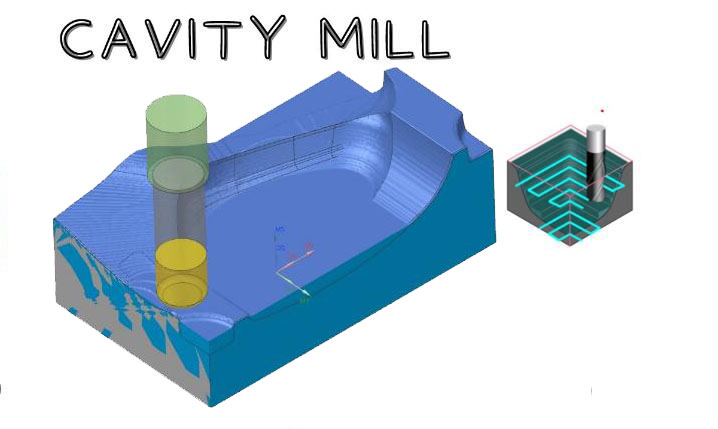Fundamentally, cavity milling is characterized by its goal: to hollow out a portion of the workpiece. It is a subtype of milling that involves removing material from the workpiece, thereby creating cavities or “pockets.”
Cavity milling, also known as pocket milling or enclosed pocket milling, involves removing material from within a defined boundary or pocket area of a workpiece. This operation is typically performed using an end mill or a similar cutting tool with multiple flutes. The tool moves along a programmed path to gradually machine away the material inside the pocket, leaving behind a cavity with the desired shape and dimensions.
In cavity milling, the cutting tool is lowered into the material at a specified depth and removes the material in successive passes following a predetermined tool path. Tool paths are designed for efficient material removal while ensuring optimal surface finish and dimensional accuracy.
Key Aspects Of Cavity Milling
Tool selection:
Tool selection is crucial. End mills are often used for this purpose, especially when complex shapes or tight corners are involved.
Depth Considerations:
Pocket depth plays an important role in tool selection and cutting parameters. Stronger funds may require specialized tools or multiple passes.
Processing Strategy:
Strategy is imperative. Generally speaking, milling starts in the center of the cavity and spirals outward. This prevents the cutter from cutting directly into the material, ensuring a smoother operation.

Finishing passes:
Initial material removal and finishing passes are performed to ensure the cavity meets required size and surface finish specifications.
Key Features Of Cavity Milling:
Efficient material removal:
cavity milling is an efficient way to remove large volumes of material from workpieces, especially when creating recesses, slots, or enclosed features.
Reduced tool wear:
By engaging multiple flutes simultaneously, cavity milling distributes the cutting forces evenly across the tool, reducing wear and prolonging tool life.
Improved chip evacuation:
The enclosed nature of cavity milling helps contain chips within the pocket area, facilitating efficient chip evacuation and preventing chip buildup on the workpiece surface.
Versatile applications:
cavity milling is widely used in various industries, including aerospace, automotive, mold making, and general machining, for producing complex components with internal features.
Versatility:
The highlight of this technology is the ability to create countless shapes from simple to complex.
Platform Accuracy:
With modern CNC machinery, cavities can be milled with extremely high precision and to tight tolerances.
Material savings:
Cavity milling saves material more than drilling, which removes and discards material.
Comparison Of Cavity Milling And Surface Milling
Both cavity milling and face milling operations create tool paths on the horizontal cutting layer to remove material allowance from the workpiece. In most cases, especially rough machining, cavity milling can replace face milling, but face milling also has its unique advantages. Below is a comparison between cavity milling and face milling.
Same point
1) Both the cavity milling and surface milling tool axes are perpendicular to the cutting layer plane.
2) Most of the parameters of cavity milling and plane milling are basically the same, such as cutting method, tool advance and retraction, control points, cutting parameter options, corner control options, etc.
Difference
1) The types of geometry that define the workpiece and the blank are different. Plane milling uses boundaries, while cavity milling mostly uses entities. Facets and boundaries can also be used.
2) The definition of cutting depth is different. Plane milling defines the total cutting depth through the height difference between the specified boundary and the bottom surface. cavity milling uses blank geometry and part geometry to define the depth of cut.



